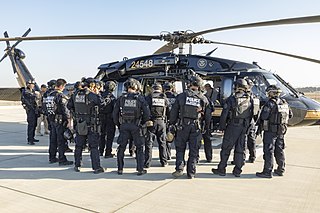
In the United States, a SWAT team is a generic term for a police tactical unit.

The Hostage Rescue Team (HRT) is the Federal Bureau of Investigation's (FBI) elite tactical unit. The HRT was formed to provide a full-time federal law enforcement tactical capability to respond to major terrorist incidents throughout the United States. Today, the HRT performs a number of tactical law enforcement and national security functions in high-risk environments and conditions and has deployed overseas, including with military Joint Special Operations Command units.
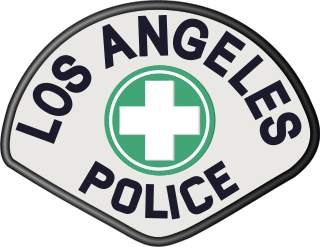
The Los Angeles Police Department (LAPD), officially known as the City of Los Angeles Police Department, is the primary law enforcement agency of Los Angeles, California, United States. With 8,832 officers and 3,000 civilian staff, it is the third-largest municipal police department in the United States, after the New York City Police Department and the Chicago Police Department.

The Iranian Embassy siege took place from 30 April to 5 May 1980, after a group of six armed men stormed the Iranian embassy on Prince's Gate in South Kensington, London. The gunmen, Iranian Arabs campaigning for sovereignty of Khuzestan Province, took 26 people hostage, including embassy staff, several visitors, and a police officer who had been guarding the embassy. They demanded the release of prisoners in Khuzestan and their own safe passage out of the United Kingdom. The British government quickly decided that safe passage would not be granted and a siege ensued. Subsequently, police negotiators secured the release of five hostages in exchange for minor concessions, such as the broadcasting of the hostage-takers' demands on British television.
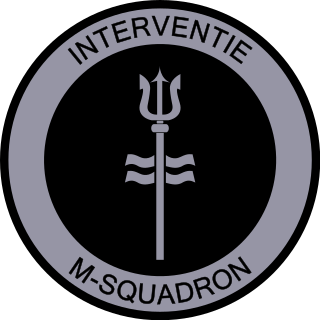
M-Squadron, formerly the Unit Interventie Mariniers, and before that known as the Bijzondere Bijstandseenheid, is an elite Dutch special forces unit which is tasked with conducting domestic counter-terrorist operations. M-Squadron is part of the Netherlands Maritime Special Operations Forces of the Netherlands Marine Corps.

The Metropolitan Police Department of the District of Columbia (MPDC), more commonly known as the Metropolitan Police Department (MPD), the DC Police, and, colloquially, the DCPD, is the primary law enforcement agency for the District of Columbia, in the United States. With approximately 3,400 officers and 600 civilian staff, it is the sixth-largest municipal police department in the United States. The department serves an area of 68 square miles (180 km2) and a population of over 700,000 people. Established on August 6, 1861, the MPD is one of the oldest police departments in the United States. The MPD headquarters is at the Henry J. Daly Building, located on Indiana Avenue in Judiciary Square across the street from the District of Columbia Court of Appeals and the Superior Court of the District of Columbia. The department's mission is to "safeguard the District of Columbia and protect its residents and visitors with the highest regard for the sanctity of human life". The MPD's regulations are compiled in title 5, chapter 1 of the District of Columbia Code.

A shootout, also called a firefight, gunfight, or gun battle, is a combat situation between armed parties using guns. The term can be used to describe any such fight, though it is typically used in a non-military context or to describe combat situations primarily using firearms.

The Special Assault Team is a police tactical unit maintained by individual Japanese prefectural police forces and supervised by the National Police Agency. It is a national-level counterterrorism unit that cooperates with territorial-level Anti-Firearms Squads and Counter-NBC Terrorism Squads. Most information on the unit has been confidential, its existence officially revealed only in 1996.

The Emergency Response Unit (ERU) is the police tactical unit of the Garda Síochána, Ireland's national police and security service. The unit was a section of the forces' Special Detective Unit (SDU), under the Crime and Security Branch (CSB) until 2017, when the Special Tactics and Operational Command was created to take over its operational duties alongside Armed Support Units.
In the United States, a no-knock warrant is a warrant issued by a judge that allows law enforcement to enter a property without immediate prior notification of the residents, such as by knocking or ringing a doorbell. In most cases, law enforcement will identify themselves just before they forcefully enter the property. It is issued under the belief that any evidence they hope to find may be destroyed between the time that police identify themselves and the time they secure the area, or in the event where there is a large perceived threat to officer safety during the execution of the warrant.

44 Minutes: The North Hollywood Shoot-Out is a 2003 American crime action docudrama television film directed by Yves Simoneau and written by Tim Metcalfe. The film stars Michael Madsen, Ron Livingston, Mario Van Peebles, Andrew Bryniarski, and Oleg Taktarov. It is a semi-fictional dramatization of the 1997 North Hollywood shootout, and follows the perspectives of bank robbers Larry Eugene Phillips Jr. and Emil Mătăsăreanu, as well as various Los Angeles Police Department (LAPD) officers involved in the shootout.
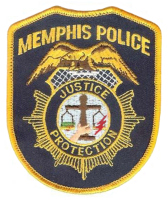
The Memphis Police Department is a law enforcement agency in Tennessee in the United States.

The Minneapolis Police Department (MPD) is the primary law enforcement agency in Minneapolis, Minnesota, United States. It is also the largest police department in Minnesota. Formed in 1867, it is the second-oldest police department in Minnesota, after the Saint Paul Police Department that formed in 1854. A short-lived Board of Police Commissioners existed from 1887 to 1890.

Metropolitan Division, commonly referred to as Metro Division or just Metro, is an elite division of the Los Angeles Police Department (LAPD) under its Special Operations Group. Metropolitan Division is responsible for managing the LAPD's specialized crime suppression, K-9, mounted, and SWAT units, named "platoons".

Aiyana Mo'Nay Stanley-Jones was a seven-year-old girl from Detroit's East Side who was shot in the neck and killed by police officer Joseph Weekley during a raid conducted by the Detroit Police Department's Special Response Team. The Team was targeting a suspect in the apartment a floor above Jones' on May 16, 2010. Her death drew national media attention and led U.S. Representative John Conyers to ask U.S. Attorney General Eric Holder for a federal investigation into the incident.

The Manila hostage crisis, officially known as the Rizal Park hostage-taking incident, took place when a disgruntled former Philippine National Police officer named Rolando Mendoza hijacked a tourist bus in Rizal Park, Manila, Philippines, on August 23, 2010. The bus carried 25 people: 20 tourists, a tour guide from Hong Kong, and four local Filipinos. Mendoza claimed that he had been unfairly dismissed from his job, and demanded a fair hearing to defend himself.
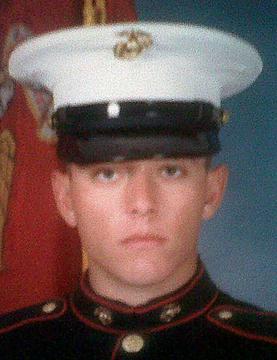
Jose Guerena was a U.S. Marine veteran who served in the Iraq War and who was killed in his Tucson, Arizona, home on May 5, 2011, by the Pima County Sheriff's Department SWAT team. Deputies were executing a warrant to search Guerena's home while investigating a case involving marijuana being smuggled into the U.S. from Mexico.

The militarization of police is the use of military equipment and tactics by law enforcement officers. This includes the use of armored personnel carriers (APCs), assault rifles, submachine guns, flashbang grenades, sniper rifles, and SWAT teams. The militarization of law enforcement is also associated with intelligence agency–style information gathering aimed at the public and political activists and with a more aggressive style of law enforcement. Criminal justice professor Peter Kraska has defined militarization of police as "the process whereby civilian police increasingly draw from, and pattern themselves around, the tenets of militarism and the military model".
On December 28, 2017, a fatal swatting incident occurred in Wichita, Kansas, United States. During an online dispute between Casey Viner and Shane Gaskill regarding the video game Call of Duty: WWII, Viner threatened to have Gaskill swatted. Gaskill responded by giving him a false address for his residence, one that was occupied by an uninvolved person, Andrew Finch. Viner then asked Tyler Barriss to make the required fraudulent call to initiate the swatting. Wichita Police responded to the address, and as Finch was exiting his house, police officer Justin Rapp fatally shot him.

On January 7, 2023, Tyre Nichols, a 29-year-old black man, was fatally injured by five black police officers in Memphis, Tennessee, and died three days later. The officers, all members of the Memphis Police Department (MPD) SCORPION unit, pulled Nichols from his car before pepper spraying and tasering him. Nichols broke free and ran toward his mother's house, which was less than a mile (1.6 km) away. Five black officers caught up with Nichols near the house, where they punched, kicked and pepper sprayed him, and struck him with a baton. Medics on the scene failed to administer care for 16 minutes after arriving. Nichols was admitted to the hospital in critical condition.

















